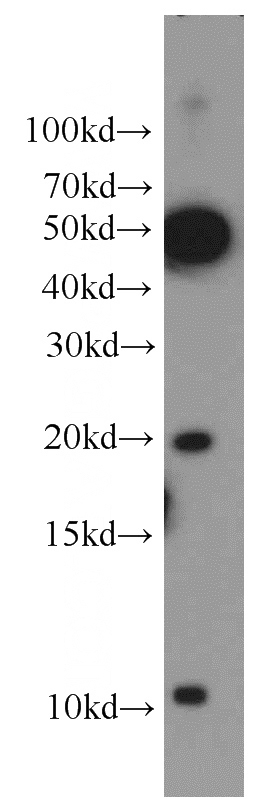-
Product Name
ID1 antibody
- Documents
-
Description
ID1 Rabbit Polyclonal antibody. Positive WB detected in PC-3 cells. Observed molecular weight by Western-blot: 20kd
-
Tested applications
ELISA, WB
-
Species reactivity
human, mouse, rat; other species not tested.
-
Alternative names
ID1 antibody; Inhibitor of DNA binding 1 antibody; bHLHb24 antibody
- Immunogen
-
Isotype
Rabbit IgG
-
Preparation
This antibody was obtained by immunization of ID1 recombinant protein (Accession Number: NM_002165). Purification method: Antigen affinity purified.
-
Clonality
Polyclonal
-
Formulation
PBS with 0.02% sodium azide and 50% glycerol pH 7.3.
-
Storage instructions
Store at -20℃. DO NOT ALIQUOT
-
Applications
Recommended Dilution:
WB: 1:200-1:2000
-
Validations

PC-3 cells were subjected to SDS PAGE followed by western blot with Catalog No:111598(ID1 antibody) at dilution of 1:500
-
Background
ID (inhibitor of DNA binding) proteins contain a helix-loop-helix (HLH) motif and regulate tissue-specific transcription within several cell lineages. They do not bind DNA directly, but inhibit lineage commitment by binding basic helix-loop-helix (bHLH) transcription factors through their HLH motif. ID1 proteins lack a basic DNA-binding domain but are able to form heterodimers with other HLH proteins, thereby inhibiting DNA binding. ID proteins contribute to cell growth, senescence, differentiation, and angiogenesis.
-
References
- Haberzettl P, Lee J, Duggineni D. Exposure to ambient air fine particulate matter prevents VEGF-induced mobilization of endothelial progenitor cells from the bone marrow. Environmental health perspectives. 120(6):848-56. 2012.
- Chen J, Sun W, Zheng Y, Xiong H, Cai Y. Bone morphogenetic protein 4, inhibitor of differentiation 1, and epidermal growth factor receptor regulate the survival of cochlear sensory epithelial cells. Journal of neuroscience research. 91(4):515-26. 2013.
- Hu F, Meng X, Tong Q. BMP-6 inhibits cell proliferation by targeting microRNA-192 in breast cancer. Biochimica et biophysica acta. 1832(12):2379-90. 2013.
Related Products / Services
Please note: All products are "FOR RESEARCH USE ONLY AND ARE NOT INTENDED FOR DIAGNOSTIC OR THERAPEUTIC USE"
